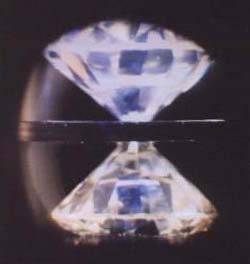Osmium is Stiffer than Diamond

Diamond is the hardest material, resisting scratches, dents, and chipping better than any other, so industrial strength machine tools often have diamond tips. But theoretically predicting new superhard materials is, well, hard. Instead, theorists prefer to model a material’s bulk modulus–its resistance to compression–which is easier to calculate than hardness. The stiffest materials also tend to be the hardest ones.
Although osmium is hard for a metal, it’s far softer than diamond, so when an estimate of its bulk modulus turned out higher than diamond, no one took it very seriously, says Hyunchae Cynn of the Lawrence Livermore National Laboratory in California. To pin the real value down, Cynn and his colleagues squeezed osmium in a so-called diamond anvil, which consists of two diamonds separated by a thin metal gasket with a 60-micron-diameter hole in the center. They filled the hole with osmium powder and argon, to distribute the pressure evenly, and crushed the metal with 600,000 atmospheres of pressure (60 GPa). X-ray diffraction patterns revealed the spacing between osmium atoms in the sample at different pressures, data that gave a bulk modulus of 462 GPa, compared to diamond’s 443 GPa.
The result is unusual because osmium is so different from other compounds with high bulk modulus, Cynn says. Diamond and some metal dioxides, which are very strong and incompressible, are usually recovered from conditions of extreme temperature and pressure. Diamond is also a light material whose atoms are covalently bonded and arrayed in a cubic structure, whereas osmium is heavy, metallic, and has hexagonally organized atoms. Cynn thinks researchers should now take a closer look at metals and other materials to see what properties they may have missed. “The lesson,” he says, “is that prediction is one thing, but [an experiment] has to be there to confirm or to set the record.”
Osmium may also offer new pathways to superhard compounds, says Cynn. Because its atoms retain their spacing at high pressures, the metal could potentially be infused with carbon, boron, nitrogen, or oxygen, all of which are common ingredients in real or proposed high-strength materials. Filling the gaps between osmium atoms could yield a high electron density, which is another indicator for hardness.
The discovery of osmium’s extreme stiffness is a solid and startling result that will likely generate a lot of research, says David Mao of the Carnegie Institution in Washington, DC. Various novel materials have challenged diamond’s preeminence in the past, but have always come up short, Mao says. “Now, suddenly, they found osmium, which is under everyone’s nose.” He says that bulk modulus remains a good marker on the path to superhard materials, but researchers will have to consider properties such as the type of bonding and crystal structure, too. No longer can they fixate on diamond as the paradigm.
–JR Minkel
JR Minkel is a freelance science writer in New York City.


